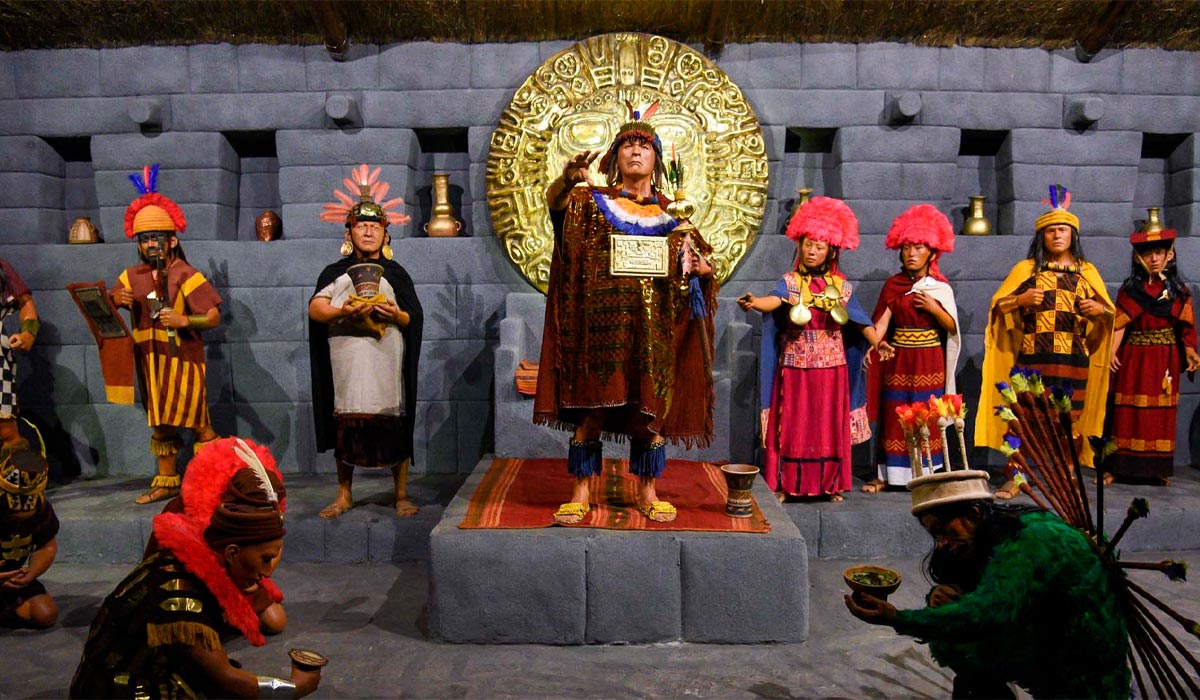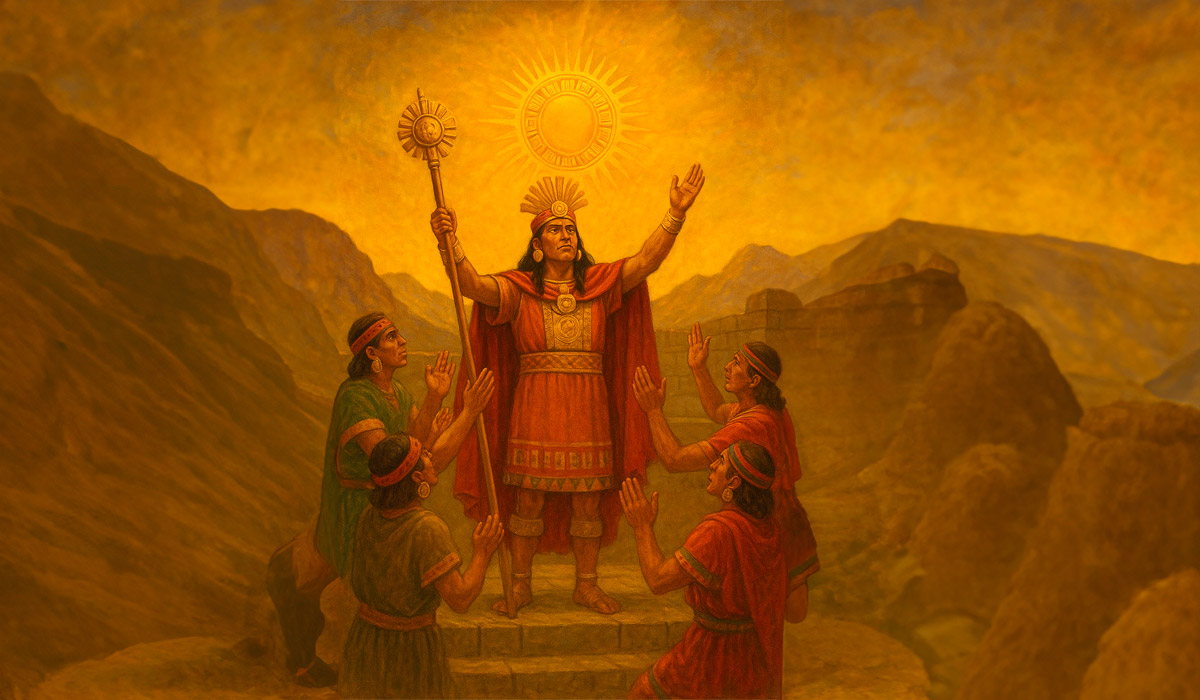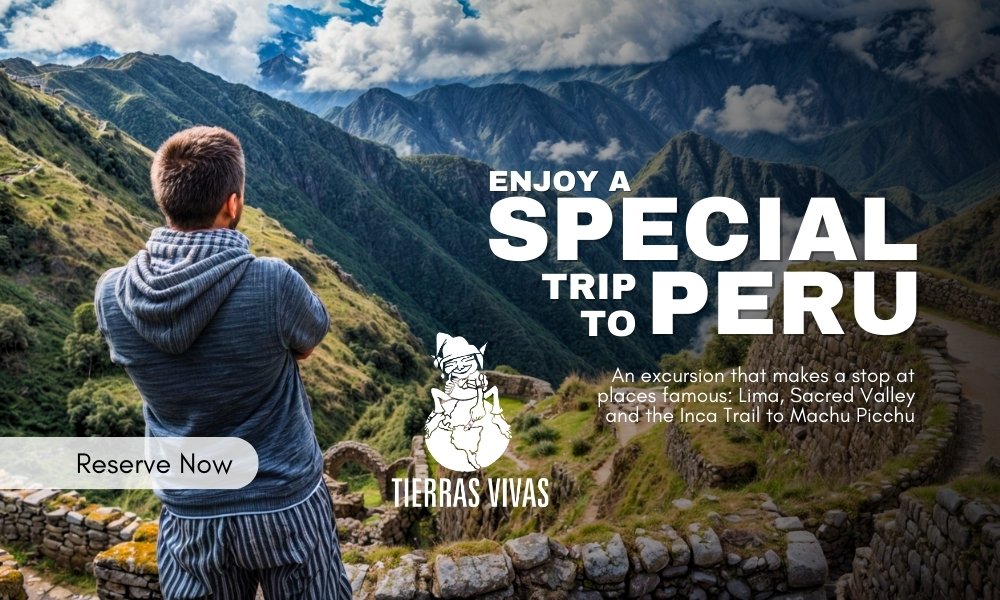In a relatively short space of time - barely a century- the Incas built not only the largest empire in pre-Columbian America but also one of the largest in history. Their vast domain encompassed dramatic contrasts, from icy peaks to coastal desert and the Amazonian jungle. With the high-altitude city of Cusco at its center. Before the arrival of the Incas in the central Andes, which some estimates put as early as AD 1000, the area was home to a host of diverse, and often hostile, cultures. The conquering Incas united the region under one social system and language but did adopt aspects of the cultures they absorbed.
The Culture of the Incas
At its height in the 15th and 10th centuries, the Inca Empire encompassed thousands of square miles, stretching almost the entire lenght of the Andes. The Incas were audacious engineers, building spectacular mountain-top citadels. They developed elaborate famring terraces, sustaining their crops by canal and drainage systems, Their social structure was extremely rigid with the emperor enjoying absolute power, and revered as a living god. The Incas worshipped the sun, moon, earth, and mountains. Animals, such as the condor and puma, were also considered sacred.
History of the Inca civilization
Historians speculate that the Inca civilization first arrived in the valley where they would later establish their capital city, Cusco, approximately around the year 1100. The region presented numerous challenges as it experienced infrequent rainfall, making it difficult to cultivate crops. Consequently, various groups often engaged in conflicts to claim the fertile land adjacent to rivers. Gradually, the Inca expanded their dominion by subduing neighboring communities, amassing more influence, and ultimately taking control of the Cusco Valley around 1300.
In the year 1438, Pachacuti Inca Yupanqui (pronounced pah-chah-KOO-tee EENG-kah YOO-pahn-wee) ascended to the throne as the ninth Inca emperor. With his sons assuming roles as military commanders, the emperor initiated a vast expansion of Inca territory, extending far beyond the confines of the Cusco region. He appointed individuals who spoke Quechua, the Inca language, to government positions. Moreover, Pachacuti Inca Yupanqui commissioned the construction of Machu Picchu, a remarkable citadel, around 1450.
Inca Empire CultureIn 1471, Pachacuti Inca Yupanqui transferred power to his son, Topa Inca Yupanqui. Under Topa Inca’s leadership, the empire witnessed unprecedented growth, with the Inca dominion encompassing the majority of western South America. During this period, the Inca ruled over a population of 12 million people who spoke approximately 30 different languages.
The Inca mandated that subjugated peoples who did not speak Quechua, such as the Chanka (speaking Aymara) and the Chimú (speaking Mochica), were required to serve in the military and participate in the construction of military outposts, temples, and an extensive road network. These roads were truly remarkable, facilitating the movement of troops and Inca officials throughout the empire. The road system featured two principal highways, one along the coastal regions and another traversing the Andes. Numerous smaller roads interconnected these main routes. The infrastructure also included tunnels, bridges, and storage facilities to supply travelers with provisions and rest areas.
Inca Religion
The Inca religion honored older groups like the Wari and Tiwanakotas. They saw Tiwanaku and Lake Titicaca as holy places because of their role in creation stories. Their main gods were Inti, the Sun god and Mama Kilya, the Moon goddess. People worshiped them in places like Coricancha in Cuzco, where priests and priestesses did ceremonies led by the High Priest of the Sun.
They believed in the pachakuti, which is like a cycle of death and new life. They had rituals based on the sky, using the sun, moon and stars. Holy places, called huacas, like mountains and springs, were used to watch the sky and for farming ceremonies.
Honoring ancestors was very important. They mummified them and gave them food, drinks, and precious things. They also did human and animal sacrifices to please the gods and keep the ruler healthy. The Incas made the people they conquered follow their religion. They built temples and kept their holy objects in Cuzco, maybe to show control and power.
Cult of the Sun
The Incas revered Inti, the Sun God, who nourished the earth and controlled the harvests. The emperor, believed to be the son of the Sun God, made offerings to the sun during religous ceremonies.
Inti Raymi (Sun God Festival) was celebrated annually on June 21, the winter solstice in the Southern Hemisphere. Mummies of nobles were brought into Cusco´s main plaza to witness the event. It is still beld on June 24 at Sacsayhuaman.
Sacrifice of animals was practised daily by the Incas. Human sacrifice was reserved for special occasions and only the most beautiful children from the most powerful families were chosen to be sacrificed.
Divination played a large part in religious life. Everything, from treating illness to determining the correct sacrifices, was performed by the high priest consulting the oracles, observing the path of a spider in a dish, the position of scttered coca leaves, or by drinking ayahuasca.
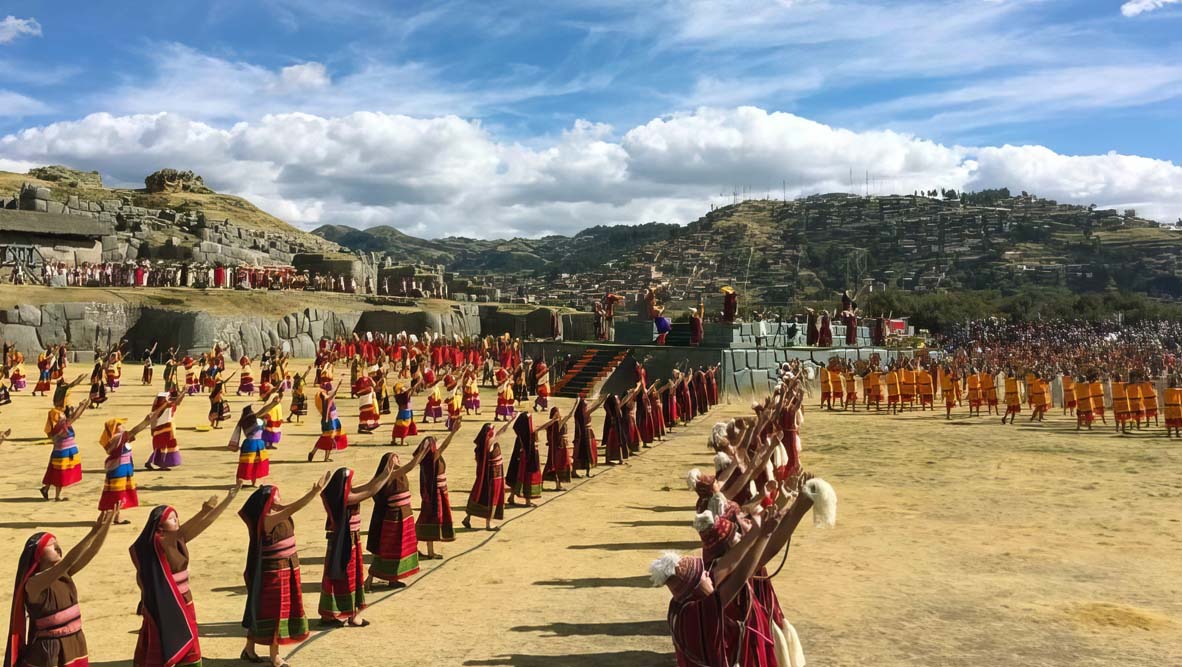
Picture: Inti Raymi festival (The sun's festival in Cusco).
Inca ruins in Peru
What most visitors from Peru do not know is that the country is full of ancient Inca ruins in Peru. Here we show you some that are worth visiting. Many of them are only a day's journey from Cuzco and can be combined with a visit to Machu Picchu.
- Moray: A town of palaces, temples and fortresses that are now World Heritage, the Sacred Valley Cusco was for the Inca Empire an extension of its capital, Cusco. Inside the valley are the remains of Moray, a gigantic set of terraces that served as an agricultural laboratory for the Incas. It is believed that the form allowed them to create different microclimates that would later be interpreted as crops at different heights.
- Choquequirao: Choquequirao is one of the alternatives to Machu Picchu most recommended by adventurers, because to reach it is necessary a trek of at least 4 days on one of the deepest canyons in America.
- Ollantaytambo: It is known as the Inca Living City, and one of the most wonderful aspects of Ollantaytambo is how the ancient ruins blend with the contemporary and peaceful life of its inhabitants. This is one of the best places to admire how the Incas carved the stone with a mastery difficult to understand with the technology they had.
- Isla del Sol: The Inca empire encompassed not only the current Peruvian territory, but also parts of Colombia, Ecuador, Bolivia and Chile. Located on the highest navigable lake in the world, Isla del Sol is the favorite destination for those who visit Titicaca.
- Waqrapukara: Waqrapukara is so unknown that it is not yet known if it was a fortress, a sanctuary or an astronomical observatory. This monument is located at 4,300 meters above sea level in the Apurimac Canyon, south of the city of Cusco. Its landscape is breathtaking, because it is surrounded by impressive platforms, squares and a giant monolith that overlooks the mountain landscape.
- Kuelap: Located on the top of a mountain at 3 thousand meters high, Kuelap offers a panoramic view that combines clouds with the green landscape of the Amazon rainforest of Peru.
The Cápac Ñan (Royal Road)
Roads were crucial to Pachacutec´s program of unification. Under his reign alone, the Incas constructed some 2,500 miles (4,000 km) of tightly packed stone roads, some scaling heights of more than 16,500 ft (5,000 m). This impressive Royal Road network of roads, about 3 ft (1 m) wide, connected all four regions of the Inca empire, running from Quito in Ecuador, past Santiago in Chile and La Paz in Bolivia to Tucuman in Argentina.
The Inca Trail Peru part of the 23,000 kilometers (approx.14,000 miles) of roads built by the Incas in South America, are on the most famous trekking route in Peru, and possibly one of the most spectacular in America. The Inca Trails Peru begins in the town of Qorihuayrachina, at kilometer 88 of the Quillabamba railway - Cusco and takes 3 to 4 days of strenuous hiking, it is the road that takes tourists to Machu Picchu. The route consists of an impressive variety of altitudes, climates and ecosystems ranging from the Andean plain to the cloud forest. Travelers cross two high-altitude areas (the highest being Warmiwañuska at 4,200 m.s.) to complete the walk with a magical entrance to Machu Picchu through the Inti Punku or Puerta del Sol.
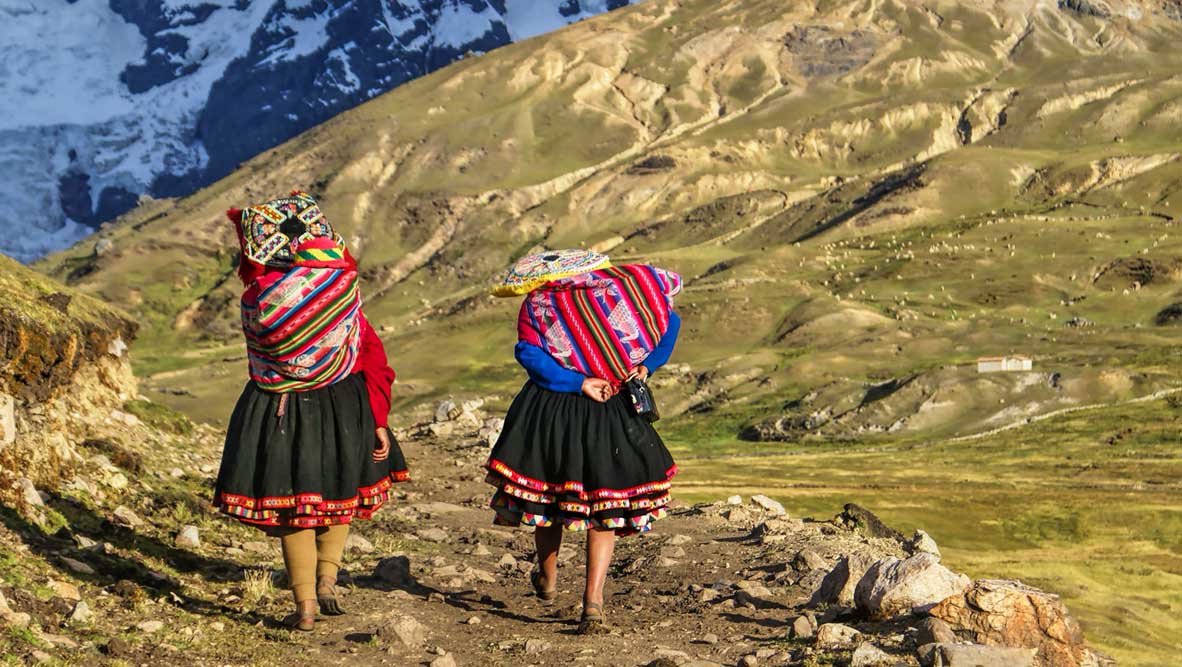
Inca Empire & Spanish Conquest
For all its glory, Inca pre-eminence only lasted around 100 years. The reign of the first eight Incas spanned the period from the 12th century to the early 15th century, but it was the ninth Inca Peru, Pachacutec, who gave the empire its first bloody taste of conquest. A growing thirst for expansion had led the neighboring highland tribe, the Chankas, to Cuzco´s doorstep around 1438, and Viracocha Inca fled in the belief that his small empire was lost. However, his son Pachacutec rallied the Inca army and, in a desperate battle, he famously routed the Chankas.
Buoyed by his victory, Pachacutec then embarked upon the first wave of Incan expansion, promptly bagging much of the central Andes. Over the next 25 years, the Inca empire grew until it stretched from the present-day border of Ecuador and Colombia. It was during this time that scores of fabulous mountaintop citadels were built, including Machu Picchu site.
When Europeans discovered the New World, epidemics including smallpox swept down from Central America and the Caribean. In 1527 the 11th Inca Huayna Capác died of such an epidemic. Before expiring he divided his empire between his two sons Atahualpa, born of a Quitan mother, who took the north, and the pure-blooded native Cuzqueñan Huáscar, who took Cuzco and the south. Civil war eventually ensued and the slow downfall of the Inca empire began.
The Fall of the Empire
By 1526 Francisco Pizarro had started heading south from Panama and soon discovered the rich coastal settlements of the Inca empire. After returning to Spain to court money and men for the conquest he returned, landing on the Ecuadorian coasts and marching overland toward Peruand the heart of the Inca empire, reaching Cajamarca in 1532, by which time Atahualpa had defeated his half-brother Huáscar.
This meeting was to radically change the course of South American history. Atahualpa was ambushed by a few dozen armed conquistadors who succeeded in capturing him, killing thousands of unarmed indigenous tribespeople. In an attempt to regain his freedom, ther Inca offered a ransom of gold and silver from Cuzco, including that stripped from the walls of Qorikancha.
But after holding Atahualpa prisoner for a number of months and teasing the Incas with ransom requests Pizarro murdered him anyway, and soon marched on Cuzco. Mounted on horseback, protected by armor and swinging steel swords, the Spanish cavalry was virtually unstoppable.
Manco Inca, the brother of Huáscar and Atahualpa, ran away from Cusco. He hid in Vilcabamba, a place deep in the jungle. From there, he fought against the Spanish for almost 40 years. In the end, the Spanish killed Túpac Amaru I, the last Inca, and that was the end of Inca power.
Inca Trail Tours
Many are the routes that take you to Machu Picchu, but none is like the Inca Trail Tours, the most famous pedestrian path in the Americas. After flying from the capital of Perú, Lima, you will arrive in Cusco to walk for four days along a path through forests and dense fog, millenary stone steps and discovering the ruins of ancient fortifications and Inca cities, and all the time enjoying majestic views.
- Salkantay Trek to Machu Picchu 5 days
- Hiking the Inca Trail to Machu Picchu 5 days
- Inca Quarry Trail 4 Days
- 2 Day Inca Trail Tour
- 2 Day Inca Trail with Camping
- 3 Day Inca Trail
- Vilcabamba Hike to Machu Picchu 6 days
- Choquequirao trek to Machu Picchu 9 days
- Ausangate trek 7 days
If you want to visit Machu Picchu, we recommend you to book your Machu Picchu Ticket in advance, so you will enjoy your Vacation in Machu Picchu without any problem.
When is the best time to hike the Inca Trail?
The best season to hike the Inca Trail is during the dry season, which covers the months April to the end of September. In October the rains begin and you can find Machu Picchu covered by clouds. If you travel in June, we recommend you to book the Inti Raymi Tour that takes place in June 24th, and also hike the Palcoyo Mountain Tour, which is an incredible Rainbow Mountain located in the Andes.

